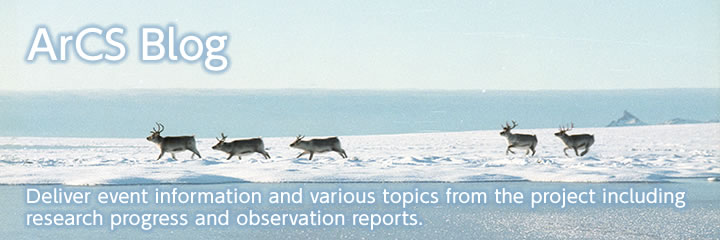After one week cruise, we arrived in the Bering Sea. It’s getting cold with a fall in temperatures below 10 degrees.

We have been making a field survey in the vicinity of the town of Whapmagoostui-Kuujjuarapik, Quebec, Canada, from the beginning of July. The region is in the transition zone of the tundra and forests. We are based in the research station of Center for Northern Studies (CEN) in Kuujjuarapik. Basically, we combine a few days stay at the station and 5-7 days camping to investigate at a field. We are running this cycle until early September.
We are visiting Whapmagoostui-Kuujjuarapik to investigate the relationship between biodiversity, ecosystem composition and function of tundra. The CEN Whapmagoostui-Kuujjuarapik (KW) station is situated on the coast of Hudson Bay in Nunavik, Quebec, Canada (55° 15' N, 77° 45' W). This place is a southern part of the Arctic tundra. Inuit and Cree First nation are living here. Inuit called Kuujjuarapik this place and Cree First Nation living here called Whapmagoostui. So there are two names at this place. Population is about 1400. There is a grocery supermarket and we can get almost anything as if we are in Japan.
Oceanographic observations by USCGC Healy were safely conducted at a total 14 fixed points in the Chukchi Sea, though sea ice sometimes blocked our path. After finishing the work at the final observation point, Healy returned to the port of Seward Alaska.
Arctic cruise by oceanographic research vessel “MIRAI” (MR16-06) is conducted from 22 August - 5 October, 2016.
Oceanographic observation in the Bowdoin fjord near Qaanaaq, northwestern Greenland (From Qaanaaq 3)
After the field observations on Bowdoin Glacier, we conducted oceanographic observations at the Bowdoin Fjord. The fjord has been studied by our research group since 2013.
The main part of our glaciological field work was targeting an area near the calving front of Bowdoin Glacier, 20 km away from Qaanaaq village. This is the most dynamic, fast changing, and, undoubtedly, the most spectacular part of the glacier to see and work at. It has been studied since 2013, and a continuation of observations is important for understanding the behavior and future of this glacier under climate change. Before Japanese researchers, this site was briefly visited only by an expedition of an American explorer, Robert Peary, 120 years ago. These days only local people occasionally visit Bowdoin fjord for narwhal hunting.
The conference of ASIW2016 was held in Tokyo during 2-3 June. Collaboration concerning technology and science between Norway and Japan has long history which motivates the conference.
The joint seminar between Theme 1 “Predictability study on weather and sea-ice forecasts linked with user engagement” and Theme 7 “People and community in the Arctic: Possibility of sustainable development” was held on June 27. The member researchers of each group discussed the topic of the Northern Sea Route (NSR). The purpose of this seminar is for the researchers and the stakeholders, gathering in the same hall, to present their own knowledge and discuss to find the best way of collaboration to make the NSR fit for practical use. First, the principal investigator of each group introduced the theme and course of the investigation, followed by presentations made by researchers of Theme 1 and 7 in turn.
I left Japan on 6th July 2016, and arrived Quebec City to have meeting at CEN (Center for Northern Studies) in University of Laval. We have an opportunity to conduct a collaborative research with Canadian colleagues, using the network of CEN’s eight field stations at from 55°N to 83°N in eastern Canada. The station of Ward Hunt Island locating in the northernmost of those stations is a study area at this time (Fig.1). The team members are six people in total (4 from Canada and 2 from Japan).




